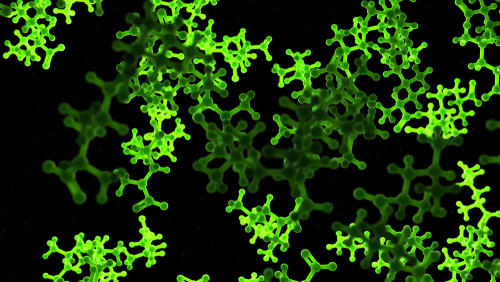Problem:
Crystallography (X-ray, neutron, electron) and cryo-electron microscopy (cryo-EM) are critical techniques used to study biological systems and develop new therapeutics. But for many decades analyzing and optimizing macromolecular structures from experimental data was a manual, time-intensive, and fraught process.
In the late 1990s, Paul Adams, then a staff scientist in Berkeley Lab’s Physical Biosciences Division (Paul is now Associate Lab Director of Berkeley Lab’s Biosciences Area), thought about automating the many procedures required for solving a structure.
Solution:
Efforts to solve this challenge began, with Berkeley Lab LDRD funding, in 1999 when he started his research group. A collaboration with researchers at Los Alamos National Laboratory, Cambridge University, and Texas A&M University then continued developing the software with support from the National Institutes of Health (NIH). Phenix, which stands for Python-based Hierarchical ENvironment for Integrated Xtallography, was built on modern programming concepts and robust advanced algorithms to automate the analysis of structural biology data. Given experimental data, the aim was for the software to automate, as much as possible, solving and completing protein crystal structures, and generating a model or set of models.
The first release of Phenix was in 2005. Subsequent work has included additional collaborators from Duke University, UTHealth, and the New Mexico Consortium, and continued funding from NIH as well as members of the biotech industry. Expanded functionality included the applications to nucleic acid structures; the ability to address ligands, which are molecules that affect the protein’s structure or function when bound; cryo-EM and neutron experimental data; and a user-friendly GUI.
Impact:
The Phenix team’s achievement over the years has changed how crystallography is conducted today, and is having a similar impact on the field of cryo-electron microscopy. The software currently has 35,000 users, including researchers in academia (the Phenix team collaborated with Nobel laureate David Baker to combine components of their Rosetta software with Phenix), government, and industry. Right now, there are more than 70 commercial licensees around the world, including leading pharmaceutical and biotech companies.
At Berkeley Lab, Phenix has resulted in royalties of $7.7 million since its inception in 2000, making it the highest grossing software product ever developed at the Lab. A significant portion of royalties is used to fund strategic Lab research projects. More importantly, it continues to help accelerate life-saving research and development.
The impact of the software suite has reached all corners of the world. Some examples, mentioned in the following stories, include:
Accelerating the development of COVID vaccines
“Work on SARS-CoV and MERS (closely related coronavirus strains) used Phenix as part of their cryo-EM analyses (Scientific Reports, BioRxiv) to reveal the different structural arrangements of the spike protein, how antibodies bind to the spike protein, and to see how mutations stabilized the protein to increase antibody response. One of these mutant forms of the spike protein was used as a critical component in the development of the BioNTech vaccine [manufactured by Pfizer]. They analyzed cryo-EM data with Phenix, to help in the preclinical development of the BNT162b2 RNA, which became one of the vaccines widely used in the U.S. to fight the SARS-CoV-2 virus.” The Molecular Imaging Behind COVID-19 Breakthroughs, Berkeley Lab News Center, March 15, 2021
Fundamental research into the Ebola virus
“While there is no known cure [for Ebola], basic research is providing insight into the action of the virus. Zachary Bornholdt and Erica Ollman Saphire from The Scripps Research Institute spearheaded a team of researchers from the University of Wisconsin-Madison, University of Tokyo, and the Japan Science and Technology Agency, studying an Ebola virus protein. The Ebola virus genome encodes for 8 proteins, one of which is VP40, a multifunctional protein with critical roles at different stages of the virus life cycle. To elucidate the VP40 structure and its related function, they crystallized the protein and collected data at three light sources, including the Berkeley Center for Structural Biology (Beamline 5.0.2) at the Advanced Light Source. The researchers analyzed the X-ray data using Phenix…[their] findings reinforce the desirability of VP40 as a target for anti-Ebola virus drugs.” Berkeley Lab User Programs Support Ebola Virus Research, biosciences.lbl.gov, April 16, 2014
Facilitated blood cancer research
“Cytokines are small proteins, e.g. growth hormone, that induce ‘signals’ inside cells when they bind cell-surface receptors. Many cytokine-induced signals pass through members of the Janus kinase (JAK) family. Mutations in JAK proteins that cause blood cancers were identified a decade ago, but it has not been determined exactly how they do so. Using data collected at the Berkeley Center for Structural Biology at the Advanced Light Source and the Phenix X-ray crystallography software developed in the Physical Biosciences Division for refinement, Genentech’s Charles Eigenbrot and Patrick Lupardus led a team that determined the kinase/pseudokinase structure of JAK family member TYK2. Based on this structural information, they proposed a mechanism for how these mutations could cause blood cancers.” Berkeley Lab Programs Facilitate Blood Cancer Research, biosciences.lbl.gov, June 2, 2014
Research into an arsenic-based antibiotic
“The emergence of antibiotic-resistant bacterial strains is among the greatest public health challenges of our time. As common antibiotics are increasingly rendered ineffective, it has spurred the search for novel drugs. A newly-discovered arsenic-containing compound produced by a soil bacterium shows promise as a broad-spectrum antibiotic…Refinement of the structure model was carried out using programs within the Phenix software suite…” BCSB Helps Characterize New Arsenic-based Antibiotic, biosciences.lbl.gov, April 14, 2019
